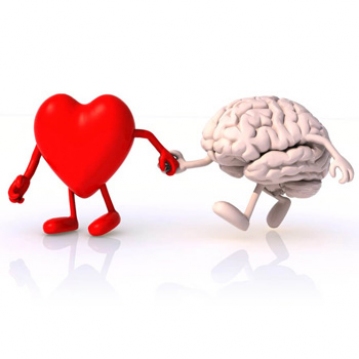
Did you see the picture on the cover? What did you think? How did you feel?
Go take a look again… what does that image say to you?
The first thing I saw was the brain, then the heart. Although you may not see a cord that links the two, turns out there is a BIG connection.
Let’s learn more. The following information is from the Institute of HeartMath in California. They have been researching the intelligence of the heart since 1991 and are the best source for this vital information.
The Heart-Brain Connection
“Most of us have been taught in school that the heart is constantly responding to ‘orders’ sent by the brain in the form of neural signals. However, it is not as commonly known that the heart actually sends more signals to the brain than the brain sends to the heart! Moreover, these heart signals have a significant effect on brain function – influencing emotional processing as well as higher cognitive faculties such as attention, perception, memory and problem-solving. In other words, not only does the heart respond to the brain, but the brain continuously responds to the heart.
“The effect of heart activity on brain function has been researched extensively over the past 40 years. Scientists at the HeartMath Institute have extended this body of scientific research by looking at how larger scale patterns of heart activity affect the brain’s functioning.
“HeartMath research has demonstrated that different patterns of heart activity (which accompany different emotional states) have distinct effects on cognitive and emotional function. During stress and negative emotions, when the heart rhythm pattern is erratic and disordered, it inhibits higher cognitive functions. This limits our ability to think clearly, remember, learn, reason, and make effective decisions. (This helps explain why we may often act impulsively and unwisely when we’re under stress.) The heart’s input to the brain during stressful or negative emotions also has a profound effect on the brain’s emotional processes – actually serving to reinforce the emotional experience of stress.
What is HeartMath?
“Although the words ‘Heart’ and ‘Math’ are rarely used together, Doc Childre, founder of the HeartMath Institute and HeartMath LLC, felt that this combination reflected the two essential aspects of their work. Heart – The word heart has meaning to almost everyone. When we think of heart, we think not only of the physical heart, but also qualities such as wisdom, love, compassion, courage and strength – the higher aspects of all human beings. Math – Math is commonly understood as a comprehensive system of equations, formulas and ways of understanding the world. In the context of HeartMath, the word math refers to the stepping stones or the nuts and bolts for systematically unfolding the qualities of the heart. It also refers to physiological and psychological equations for accessing and developing the incredible potential of the heart. The term HeartMath represents the importance of both aspects in our exploration of the heart.
Your Heart’s Changing Rhythm
“The heart at rest was once thought to operate much like a metronome, faithfully beating out a regular, steady rhythm. Scientists and physicians now know, however, that this is far from the case. Rather than being monotonously regular, the rhythm of a healthy heart – even under resting conditions – is actually surprisingly irregular, with the time interval between consecutive heartbeats constantly changing. This naturally occurring beat-to-beat variation in heart rate is called heart rate variability (HRV). Heart rate variability is a measure of the beat-to-beat changes in heart rate. The momentto-moment variations in heart rate are generally overlooked when average heart rate is measured (for example, when your doctor takes your pulse over a certain period of time and calculates that your heart is beating at, say, 70 beats per minute).
Why is HRV Important?
“Scientists and physicians consider HRV to be an important indicator of health and fitness. As a marker of physiological resilience and behavioral flexibility, it reflects our ability to adapt effectively to stress and environmental demands. HRV is also a marker of biological aging. In general, emotional stress – including emotions such as anger, frustration and anxiety – gives rise to heart rhythm patterns that appear irregular and erratic. Scientists call this an incoherent heart rhythm pattern. Likewise, the incoherent patterns of physiological activity associated with stressful emotions can cause our body to operate inefficiently, deplete our energy, and produce extra wear and tear on our whole system. This is especially true if stress and negative emotions are prolonged or experienced often. In contrast, positive emotions send a very different signal throughout our body. When we experience uplifting emotions such as appreciation, joy, care and love, our heart rhythm pattern becomes highly ordered, looking like a smooth, harmonious wave. This is called a coherent heart rhythm pattern. It’s no wonder that positive emotions feel so good – they actually help our body’s systems synchronize and work better.”
Jump online to HeartMath.org to take their complimentary Well-Being Survey and learn more about the coherence of your heart.
This is an ideal month to get to the heart of the matter – to feel more joy, compassion, happiness and… Love.
May you be inspired to See Love and Be Love each and every day!























